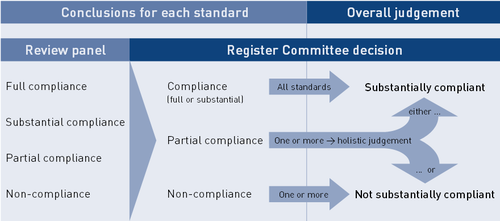Criteria for inclusion
Quality assurance agencies that wish to be included in the Register need to demonstrate that they operate in substantial compliance with the Standards and Guidelines for Quality Assurance in the European Higher Education Area (ESG).
Standards and Guidelines for Quality Assurance in the European Higher Education Area (ESG)
The focus of the ESG is on quality assurance related to learning and teaching in higher education, including the learning environment and relevant links to research and innovation. The ESG apply to all higher education offered in the EHEA regardless of the mode of study or place of delivery. Thus, the ESG are also applicable to all higher education including transnational and cross-border provision.
At the heart of quality assurance activities are the twin purposes of accountability and enhancement. Taken together, these create trust in the higher education institution’s performance.
The standards for quality assurance are divided into three parts that are intrinsically interlinked:
- Part 1. Standards and guidelines for internal quality assurance
- Part 2. Standards and guidelines for external quality assurance
- Part 3. Standards and guidelines for quality assurance agencies
To ESG can be accessed under the links below:
- English version of the ESG (official version, PDF Document);
- ESG in other languages (a number of unofficial translations are available on the ENQA website).
It should, however, be noted that for the purpose of inclusion on the Register only the English original version of the ESG shall be relevant.
The Register Committee’s interpretation of the ESG is explained in EQAR’s policy paper Use and Interpretation of the ESG. A short summary is presented below.
Substantial Compliance with the ESG
The criterion for inclusion on the Register is substantial compliance with the ESG. The Register Committee makes a holistic judgement on the agency’s compliance with the ESG as a whole, based on the external review panel’s findings, analyses of and conclusions on the agency’s compliance with the relevant standards.
Part 2 and Part 3 of the ESG are those with direct relevance to quality assurance agencies and thus serve as criteria for inclusion on the Register. While the standards in part 1 may be addressed differently depending on the type of external quality assurance carried out, the agency is expected to systematically include all standards of Part 1 of the ESG in their criteria and procedures used to evaluate, accredit or audit institutions or programmes.
In reviewing the application the Register Committee does an assessment of each standard and concludes on:
- compliance (which may be full or substantial),
- partial compliance and
- non-compliance.
If the agency is in compliance with all standards it is in substantial compliance with the ESG as a whole.
The Register Committee’s final judgement on the agency’s compliance with the ESG as a whole can either be:
- substantially compliant or
- not substantially compliant.
There is no distinction between substantial compliance and full compliance, since for inclusion on the Register it is sufficient to substantially comply with the ESG. Likewise, if the conclusion is not substantially compliant, no difference is made between partial or no compliance (see figure below).
If the Register Committee founds that there are grounds for rejecting the application, the agency is invited to make additional representation, after which the Register Committee takes a final decision.
